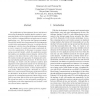CN
2007
13 years 11 months ago
2007
We argue that the design principles of the TCP timeout algorithm are based solely on RTT estimations and may lead to flow synchronization, unnecessary retransmission effort and ...
CN
2007
13 years 11 months ago
2007
Most users have multiple accounts on the Internet where each account is protected by a password. To avoid the headache in remembering and managing a long list of different and un...
CN
2007
13 years 11 months ago
2007
CN
2007
13 years 11 months ago
2007
In this paper we analyze a novel paradigm of reliable communication which is not based on the traditional timeout-andretransmit mechanism of TCP. Our approach, which we call Fount...
CN
2007
13 years 11 months ago
2007
In this paper, we present a new end-to-end protocol, namely Scalable Streaming Video Protocol (SSVP), which operates on top of UDP and is optimized for unicast video streaming app...
CN
2007
13 years 11 months ago
2007
The proliferation of heterogeneous devices and diverse networking technologies demands flexible models to guarantee the quality-of-service(QoS) at the application session level, ...
CN
2007
13 years 11 months ago
2007
Receiver-driven TCP protocols delegate key congestion control functions to receivers. Their goal is to exploit information available only at receivers in order to improve latency ...
CN
2007
13 years 11 months ago
2007
We present a new paradigm, called “Global ISP” (G-ISP). Its goal is to solve, or at least alleviate, problems of inter-domain routing, such as slow convergence, and lack of Qo...
CN
2007
13 years 11 months ago
2007
This paper presents an interaction taxonomy for classifying and identifying requirement interactions in software systems. The proposed taxonomy is in the form of a four-layered py...
CN
2007
13 years 11 months ago
2007
Since traditional telecommunication networks assume dumb terminals, there are rarely feature interactions involving end systems. However, in Internet telephony systems, such featur...




